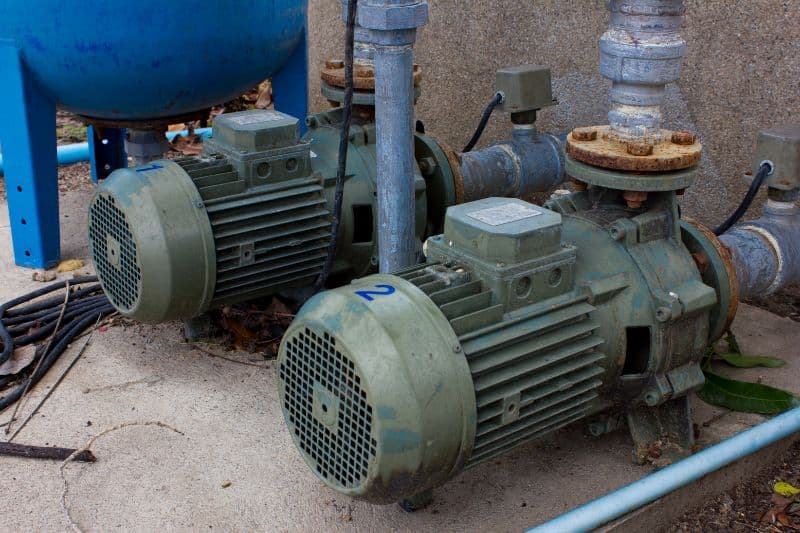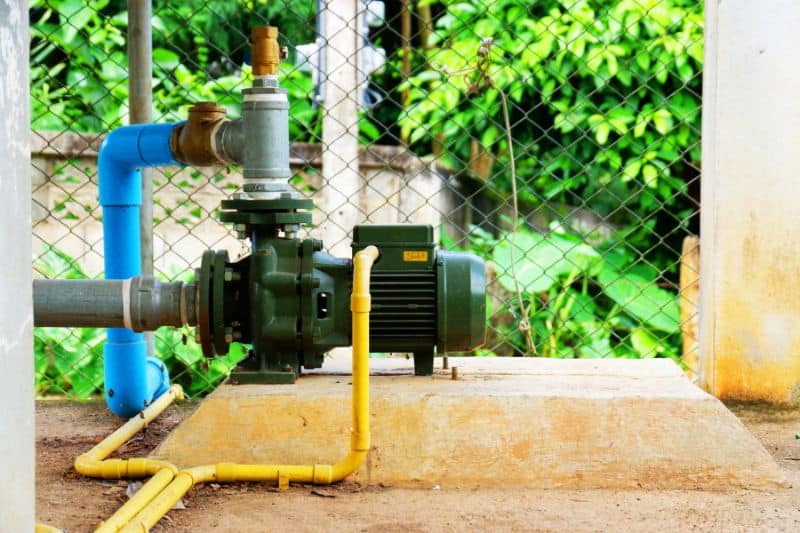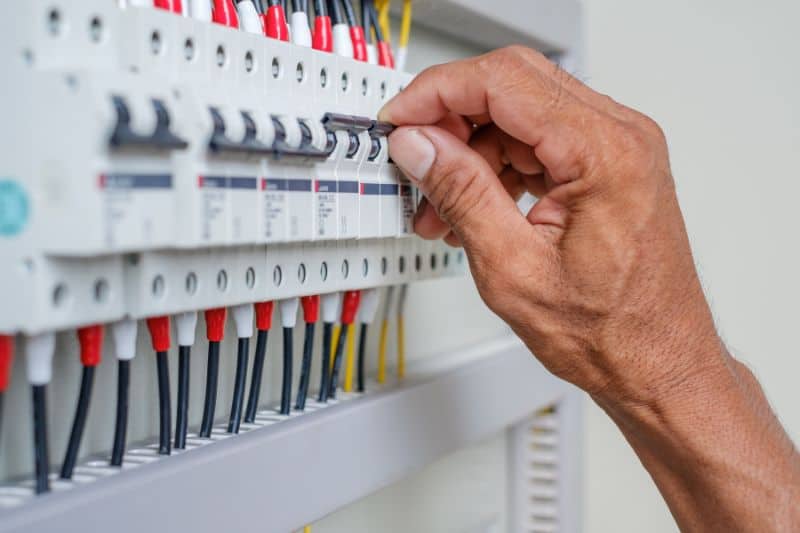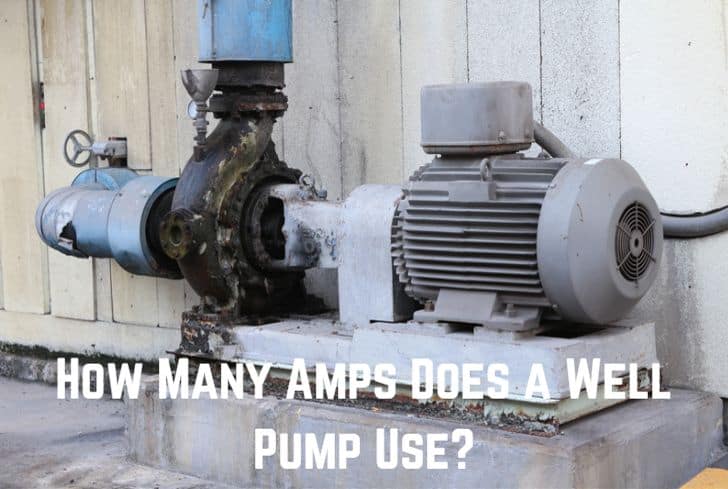If you’re in the same category as the 23 million people in the United States who own a well, you know how indispensable a reliable well pump can be. This handy device ensures a constant water supply, so you don’t have to worry when your local water authority is on strike or there’s a drought. But have you ever wondered how many amps a well pump uses?
In this blog, we’ll discuss everything you need to know about the amperage requirements of pumps. We’ll look at the amperage draw for pumps with different horsepower (HP) ratings so you can decide what’s best for you when shopping for a new pump or choosing the wire size for your configuration.
Let’s get right into it!
Read: How Many Amps Does a Hot Tub Use

How Many Amps Does a Well Pump Use?
The amperage requirements of a well pump will vary depending on the unit’s horsepower and voltage. But generally, pumps with a higher HP will require more amps than those with a lower HP, assuming all other factors remain constant.
Before I proceed, 1 HP is equivalent to 746 watts of power.
Now, assuming you know the voltage, it may seem easy to find the amperage draw of your unit. After all, Ohm’s law states that I=V/R, right?
Well, while this formula applies in several instances, we can’t use it when it comes to motor-powered units, and I’m about to tell you why!
You see, the HP rating on the appliance denotes the output power. So, there’s no way you can use that wattage rating to find the amperage draw.
Instead, you’ll need to factor in the efficiency of the unit. The goal here is to find how many watts the unit needs as the input for it to deliver the output of 746 watts. the 1HP. To do that, you need to divide the output wattage by the pump’s efficiency to get the input wattage.
Once you have the input wattage, factor in the power factor of the machine. The power factor is the ratio between the real power that the device uses to generate its output and the apparent power. It’s a good idea to assume a power factor of 85% (0.85) for most well pumps.
Throughout our examples, we’ll use the efficiency rating of 90% or 0.9, but check your unit’s documentation to be sure.
With that said, let’s move on to some numbers!

How Many Watts Does a 1/2 HP Well Pump Draw?
A 1/2HP well pump draw will draw approximately 4.06 amps at 120V and 4.43 amps on a 110V circuit. At 240 volts, the amperage draw is lowest at about 1.55 amps. That’s relatively low, but it’s nothing to scoff at.
I know you’re probably wondering how we arrived at these numbers. Well, here are some simple steps;
Step 1: Convert ½ HP to watts
1HP = 746 Watts
½ HP = ?
=373 Watts (output wattage)
Step 2: Factor in efficiency (90% in our case)
Input wattage = (373/0.9)
= 414.44 watts
Step 3: Multiply the voltage (120) by the power factor (PF) of 0.85
= 120 x 0.85
= 102 volts
Step 4: Divide the input wattage (414.44) by the result of step 3 (102);
= 414.44/102
= 4.06 amps
These numbers will change depending on the voltage your pump is running on. If you have a 110V circuit, the amp draw will be higher because the voltage is lower.
If you find the above calculations to be confusing, don’t worry.
Here’s an alternative method
Amps = HPs x 746/ (voltage x power factor x efficiency)
= 373/ (120 x 0.85 x 0.9)
= 373/91.8
= 4.06 amps
As you can see, the two methods produce the same results. So, feel free to use whichever one you’re more comfortable with.
Now, let’s see how the amperage draw changes when we increase the HP rating of our well pump.

How Many Amps Does a 3/4 HP Well Pump Use?
A 3/4 HP well pump uses approximately 6.09 amps on a 120-volt system and 6.64 amps connected to a 110-volt circuit. If you go for the higher voltage, 240 volts, the number of amps won’t be as high. In this case, it will only be 3.05 amps.
Let’s follow the previous steps to see how we arrived at those numbers. But here, we’ll use the alternative method this time.
Amps = HPs x 746/ (voltage x power factor x efficiency)
= 559.5/ (120 x 0.85 x 0.9)
= 6.09 amps
As you can see, the amperage draw is slightly higher than that of a 1/2 HP well pump. That’s to be expected, though, because the HP rating is higher.
Now, let’s see how much current a 1 HP pump will draw.
Read: How Many Amps And Watts Does an Electric Stove Use
How Many Amps Does a 1 HP Well Pump Use?
An average size pump rated 1HP will use approximately 8.13 amps on a 120-volt system and 8.87 amps connected to a 110-volt circuit. And like before, the amperage draw is lower at 240 volts with just 4.06 amps.
Here’s how we’ve arrived at those numbers;
Amps = HPs x 746/ (voltage x power factor x efficiency)
= 746/ (120 x 0.85 x 0.9)
= 8.13 amps
But keep in mind that this amperage assumes that you’re using a 120-volt system, that your pump has a 90% efficiency rating, and that the power factor is 85%. If either of those things is different, the amperage draw will also differ.
How Many Amps Does a 1.5 HP Well Pump Use?
A 1.5 HP well pump uses approximately 12.19 amps using a 120-volt system and 13.3 amps on a 110-volt circuit. As usual, the amperage draw is lower when the voltage is higher at 240 volts with just 6.09 amps.
Here’s the breakdown of those numbers;
Amps = HPs x 746/ (voltage x power factor x efficiency)
= 1119/ (120 x 0.85 x 0.9)
= 12.19 amps
How Many Amps Does a 2 HP Well Pump Use?
As for a 2 HP well pump, it will use about 16.25 amps when running on a 120-volt system and 17.73 amps when connected to a 110-volt circuit. The amperage draw is obviously lower when the voltage is increased to 240 volts at just 8.13.
Here’s the work behind those numbers;
Amps = HPs x 746/ (voltage x power factor x efficiency)
= 1492/ (120 x 0.85 x 0.9)
= 16.25 amps
So, it depends on the HP rating of your pump as to how many amps it will use. The higher the HP, the higher the amount of power your water pump needs. But again, remember to factor in the efficiency and power factor ratings, as they will also affect the amperage draw.
What Size Breaker Should a Well Pump Be on?
An average-size pump will work with 20 or 30 amps, but some may require a larger amp breaker. To be safe, always check with the manufacturer’s specifications to see what size breaker is recommended for your model. Sometimes, a pump may require a 40 amp or larger circuit breaker.
Following what the manufacturer recommends in the manual when choosing the breaker size for a well pump is ideal. The manufacturer considers the voltage drop, distance, NEC code recommendations, and more to determine the best number.

Why Does My Well Pump Keep Tripping the Breaker?
A well pump may trip the breaker for a few reasons. It could be due to overloading, short-circuiting, issues with the pump motor, pests, or even a clogged impeller. Always check with a professional to identify the root cause of the problem before trying to fix it yourself.
Overloading
The most common reason a pump trips the breaker is that it’s trying to draw more amps than the breaker can support. This usually happens when the well pump is getting old and isn’t as efficient as it used to be. To determine whether this could be the cause, you’ll need a well-pump technician to examine your appliance.
Short Circuit
Sometimes, water can leak into the pump, causing a short circuit. This can happen if there’s a crack in the casing, faulty wiring, or the seal around the shaft is worn out. If you suspect your appliance has a short circuit, it’s best to get it checked out by a professional.
Pests
Pests can cause problems for your well pump, including tripping the breaker. Mice and other small rodents are known to chew through wires, which can lead to a short circuit. If you suspect this to be the case, try setting up a trap.
Clogged Impeller
A clogged impeller can also cause your well pump to trip the breaker. The impeller is responsible for moving water through the pump, so if it gets clogged, the pump has to work harder to move the water. This can cause it to overload the breaker.
Read: How Many Amps and Watts Does a Washing Machine Use
Is It OK To Run a Well Pump 24 Hours?
Yes, running a well pump for 24 hours is OK, but that will depend on the type of motor you’re using. A high-quality starter kit sump pump can operate for 24 hours, but most shouldn’t run for more than 2 hours.
In fact, even with the most hardworking and durable water pump, it’s still important to give it time to cool down. Running it too long can cause the pump’s motor to overheat and eventually fail. So, take breaks in between to prolong the life of your pump.
Frequently Asked Questions
Can I Plug My Well Pump Into a Generator?
Yes, plugging a well pump into a generator is a great way to ensure that your pump will continue to run in the event of a power outage. However, you must ensure the generator is powerful enough to run the pump. A 3-4 kilowatt (kW) generator should be sufficient for most pumps with a ½-2HP motor.
Can You Run a Well Pump With a 2000 Watt Generator?
Yes, you can run a well pump with a 2000-watt generator, but it is important to note that only smaller pumps should be used for this purpose. Ideally, a 2000-watt generator should only be used for well pumps with a 3/4HP motor or less.
Are Well Pumps 120 Or 240?
The voltage of a well pump can vary, but most pumps are available in 120 and or 240-volt configurations. 120-volt pumps are more common in smaller HP models, while 240-volt pumps are more common in larger models.
Final Verdict
The amperage of a well pump is an essential factor to consider when sizing the breaker, choosing the ideal generator, or even when you want to gauge the pump’s power usage. And while the amp draw of this piece isn’t indicated; you can easily calculate it by using the provided information about the pump. Just follow the simple formula provided, and it will give you the amperage of your pump.






